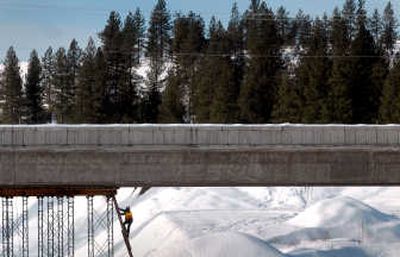Some question freeway as city addresses climate change

As Spokane leaders this week launched a new effort to slow climate change, they’re also considering tax increases to build a new freeway.
It’s a combination that some officials say doesn’t mix.
New doubts about the freeway have arisen amid concerns about global warming and Gov. Chris Gregoire’s recent demand for local taxpayers to fund a portion of the $1.5 billion cost to complete the North Spokane Corridor.
County Commissioner Bonnie Mager said given the giant costs and new demands for local funding, the highway “doesn’t look like it’s going to materialize.” Climate change and the world’s questionable supply of oil are other reasons to reconsider, she said.
“We should be re-examining some of the choices that have been made in the past and see if they still fit the reality we live in,” Mager said.
Her concerns are echoed by City Councilman Richard Rush.
Although the proposed north Spokane freeway has been controversial, in recent years politicians have been nearly united in their support.
Spokane Mayor Mary Verner said the state’s funding demand is forcing a new examination of the freeway and transportation priorities, but she remains supportive of the corridor because there’s a strong need to divert truck traffic off local roads, and because it includes land that will be set aside for light rail.
Councilman Al French said the freeway would bring new industries and jobs to the region.
“I clearly think it’s a priority for the region and so do the majority of all the other local officials in the region,” French said.
Melissa Ahern, who leads the Northwest Climate Change Center, said the freeway should be re-evaluated as oil prices continue to rise. Light rail powered by electricity might be a better investment, she said.
The city likely will consider the topic as it spends the next year creating a plan to deal with climate change, said Spokane’s new sustainability coordinator, Susanne Croft.
State transportation officials argue that the north Spokane freeway would lower pollution because those commuting to Spokane and trucks passing through would not have to deal with stop-and-go traffic on arterials such as Market and Division.
“The freight’s already coming,” said Jeff Severs, chief operating officer of Greater Spokane Inc. The freeway would get “the 18-wheelers out of the neighborhoods.”
But Daniel Lerch, program manager of the Post Carbon Institute’s cities program, said history shows that building highways increases pollution because they encourage sprawl and more driving.
“That’s a fallacy that you’re going to reduce pollution by building a highway,” said Lerch, who was brought to Spokane by Verner this week to speak about climate change and oil.
About half of the route – U.S. Highway 395 to Francis Avenue – is funded, and much of it will open next year. The second part is more costly because some of the route goes through developed neighborhoods.
K.C. Traver, president of Inland Empire Rail Transit Association, said leaders should consider a cost-benefit analysis for the corridor. He noted that a light-rail system between Spokane and Liberty Lake would cost about $17 million a mile to build – much less than the freeway.
The city will contemplate the freeway as it forms a plan to deal with high oil costs and climate change.
Lerch, who has written a guide for cities to deal with climate change, said local governments must take matters in their own hands.
“There is not necessarily any higher-level government or agency that is looking out for them,” he told a standing-room-only crowd Wednesday night at the downtown Spokane Library.
Last year, former Spokane Mayor Dennis Hession signed the U.S. Mayors Climate Protection Agreement, which pledges the city to cut global warming pollution to 7 percent below 1990 levels.
Verner has expanded on that by using a state grant to hire Croft to craft the climate change action plan. Many ideas will save the city money, the mayor said.
“The environmental incentive, of course, is very great because we want to be good stewards of our natural resources,” Verner said. “But we also need to be good stewards of the budget.”
Among the largest sources of carbon dioxide in Spokane County is the city’s trash incinerator. The Waste-to-Energy Plant releases 6 million tons of carbon dioxide annually, the city says. Challenges poised by the plant will be considered in the plan, city officials say.
Meanwhile, Verner said she’s trying to set a good example.
“Ladies are probably walking into dark ladies rooms and wondering who turned off the lights,” she said.